Lesson 12.3: Evolution Continues Today - Can We Control It?
Lesson 12.3: Evolution Continues Today - Can We Control It?
Lesson Objectives
Recognize that the process of evolution by natural selection continues to change our world and our selves, both despite and because of our best efforts to control it.
Understand that we have added direct observation of natural selection to the evidence for evolution.
Evaluate the importance of artificial selection to human life.
Discuss our use of hybridization to improve yield and adapt crops to many climates.
Explain how cloning contradicts the principles of natural selection.
Compare genetic engineering to traditional methods of breeding and domestication.
Use the concept of natural selection to explain the resistance of bacteria to antibiotics and insects to pesticides.
Explain why an individual bacterium cannot on its own change from sensitive to re-
sistant towards antibiotics.
Assess the severity of the problem of antibiotic resistance.
Recognize that viral epidemics occur when chance viral mutations adapt the virus to new hosts.
Describe the evidence for natural selection among Darwin’s finches documented by the Grants.
Introduction
Much of the immediate success of Darwin’s book was due to his careful comparison of his new idea of natural selection to the well-known breeding of animals. Darwin was especially interested in pigeons, and his observations of their many varieties inspired his own early thinking. Humans have relied on artificial selection ever since we first put seeds in the ground some ten thousand years ago. Today, our continuing efforts to develop crops and animals for food, work, and companions have expanded beyond breeding to include genetic engineering. Dismay about our effects on the environment is encouraging us to see ourselves more as a part of nature than above it; perhaps we will eventually abandon Darwin’s term “artificial selection” in favor of coevolution. Evolution by natural selection is not just an explanation of the history of life. The process of Darwin’s theory clearly continues, changing our world and ourselves - both despite and because of our best efforts to control it. And we have reached beyond Darwin’s wildest expectations; we now have direct observations of natural selection to add to the overwhelming evidence for evolution.
Artificial Selection - or Coevolution?
The range of variations induced in relatively short periods of time by animal breeders con- vinced Darwin that natural selection across geologic time could have produced the great diversity of present life. Domestication of animals has resulted in the remarkable variety of dogs (Figure 12.25) from wolves, as well as cattle, horses, llamas, camels, and a few evolutionary dead-ends, such as the donkey.
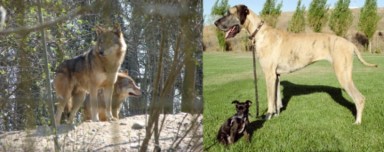
However, artificial selection has resulted in the achievement that extends far beyond our immediate, intentional goals. Our initial cultivation of plants such as corn (Figure 12.26) played a role in the eventual development of human civilization.
Since Darwin’s time, selective breeding and hybridization – mixing of separate species - has become even more sophisticated. We have further hybridized high-yield hybrids with local varieties throughout the world, intentionally adapting them to local climates and pests. Unfortunately, our widespread destruction of habitat is eroding the species and genetic diversity which provides the raw material for such efforts. Moreover, against our intent, our hybrids sometimes interbreed with natural varieties in the wild, leading to what some call genetic pollution. An example is a tiger, thought to be pure Bengal but actually a Bengal-Siberian hybrid, released in India to demonstrate the survival abilities of captive- raised tigers. The tiger did survive – to pollute the genetically pure Bengal population in a national park with northern-adapted Siberian genes (Figure 12.27).
The new field of biotechnology has dramatically changed our quest to improve upon natural selection. Ironically, one new development intentionally undermines the very foundation of Darwin’s theory. As the first mammal to be cloned, a sheep name Dolly showed breeders of animals from farms to racetracks that they could copy “ideal” individuals without the bothersome variation which accompanies sexual reproduction (Figure 12.28). Many people hope that future decisions about cloning will consider Darwin’s lessons about the value of variation in unpredictable, changing environments.
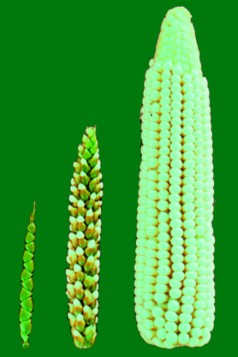

Figure 12.27: The natural genes which adapted the Indian Bengal tiger (Panthera tigris tigris, left) and the Russian Siberian tiger (Panthera tigris altaica, right) to their unique habitats were mixed or “polluted” when a captive hybrid was released into a national park in India. The “escape” of non-native genes into a wild population is genetic pollution. (4)
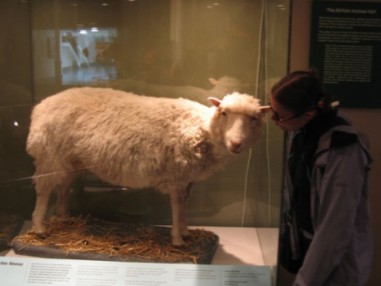
Another contribution of biotechnology is genetic engineering, the transfer of a gene from one organism to another. First, we inserted the human gene for insulin into bacteria, which – as bacteria use the same universal Genetic Code as we use – read the DNA and produced the human protein for use by diabetics. Many more cost-saving and designer medical advances have followed, including
production of clotting factors for hemophiliacs
vaccines for devastating diseases such as hepatitis B
a breast cancer “designer drug,” herceptin
the potential for cheap, effective vaccines in fruits such as bananas
We have extended genetic engineering to agriculture, improving range, nutrition, resistance to disease, and other aspects of life. Transgenic animals - which possess genes from another species - now produce vaccines and hormones, serve in scientific research, and entertain us as pets (Figure 12.29). However, as for traditional agriculture, fears surround potential cross-pollination and interbreeding with wild populations. Modified genes have been found in plants up to 21 km (13 miles) away from their source. If such transfers spread resistance to herbicides or pesticides to wild populations, they will have defeated their intended purpose.
In his book, The Botany of Desire, Michael Pollan questions our feelings of superiority over our domesticated plants and animals. Discussing our domestication of the apple for its sugar,

the tulip for its beauty, marijuana for its psychogenic effects, and the potato for its food value, Pollan takes the plants’ view of the evolving relationships. Could it not be that, as we have selected and modified these plants, they have also selected us for our powers to ensure their survival and reproduction – and changed us in the process? Are domestication of animals, cultivation of plants, and selective breeding actually forms of coevolution? Pollan’s delightful yet sobering treatise may reflect a growing realization that we humans are as much a part of nature as any other species. Yes, we can influence evolution in a number of ways. However, we remain subject to natural selection, and every choice we make has effects on evolution – including our own. As we have already seen, and will see again in the next topic, our choices often have unintended effects.
Evolution of Resistance
In almost unprecedented actions during May 2007, United States government agencies put a US citizen on a no-fly list, urged border agents to detain him, failed to detect his re-entry into the US, and eventually ordered him into involuntary isolation, urging individuals who had flown with him on several international flights to be tested for XDR-TB. Why were such drastic measures needed? What is XDR-TB, and how did it originate? The answers show evolution in action today - in a way that all of us need to understand for our own well-being.
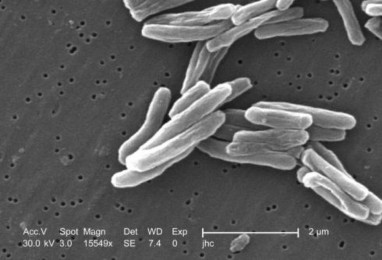
Tuberculosis (TB) has infected and killed humans since at least 4000 BCE. Today, over one-third of the world’s population has been exposed to the bacterium which causes tuberculosis (Figure 12.30), but 90% of those carry the microorganism without symptoms. In the past, the 10% who did develop the characteristic lung infection had a 50% chance of dying. The advent of antibiotics in the mid-20th century dramatically improved survival, although the slow-growing bacteria required treatments of 6-12 months rather than days. Just 40 years later, in the 1990s, a new strain appeared with a mortality rate comparable to lung cancer
up to 80%. MDR-TB, or multi-drug resistant TB, is not treatable by two of the most effective anti-TB antibiotics. Then, about the year 2000, a second, more menacing strain emerged. XDR-TB, or extensively drug-resistant TB, is not treatable by either the two major drugs or the less-effective “second line” drugs now used to treat MDR-TB. Late in 2006, an epidemic of XDR-TB developed in South Africa. Currently there are no available drugs that can effectively treat this strain of TB.
Clearly these strains of TB are new, and changing rapidly. The evolution of resistance is a growing problem for many disease-causing bacteria and also for parasites, viruses, fungi, and cancer cells. The “miracle” of drug treatment which appeared to protect humans from disease may be short-lived. How does resistance happen? How can we prevent it?
First, recognize that resistance describes the bacterium (or other microorganism) – not the human. Bacteria multiply much more rapidly than humans, and therefore can evolve much more rapidly. Consider a population of bacteria infecting an individual with tuberculosis. Like all populations, individuals within that population show variation. Mutations add more variation. By chance, mutation may change the chemistry of one or a few bacteria so that they are not affected by a particular antibiotic. If the infected human begins to take antibiotics, they change the environment for the bacteria, killing most of them. However, the few bacteria which by chance have genes for resistance will survive this change in environ- ment - and reproduce offspring which also carry the genes. More and more of the bacterial population will be resistant to antibiotics, because the antibiotics select for resistance. The bacteria are merely evolving in response to changes in their habitats! If the resistant bacteria are transmitted to another human “habitat,” their population continues to expand, and if the new “habitat” takes different drugs, natural selection may result in multi-drug resistance (Figure 12.31).
How widespread is the problem? Staphylococcus aureus bacteria first showed resistance to penicillin just four years after the drug was put into use; today, some strains have shown resistance to nearly all antibiotics. These are now known as one of several “superbugs.” The Human Immunodeficiency Virus (HIV) has become resistant to several antiviral drugs, and cancer cells within an individual often evolve resistance to chemotherapy drugs. Pesticide resistance is evolving in a similar manner; U.S. crop losses to insect pests have increased from 7% in the 1940s to more than 13% in the 1980s, despite the use of more types of pesticides in the 1980s.
What can we do about this particular instance of evolution which we have unwittingly encouraged? In general, we should reduce the use of antibiotics where possible and safe in order to lessen the selective pressure on bacteria. Here are some practices to keep in mind:

Figure 12.31: The development of resistance to antibiotics is a classic example of natural selection. Before selection, a number of heritable variations in level of resistance exist within the population (see legend at bottom). After selection by antibiotics, only those bacteria resistant to antibiotics survive. Only these resistant bacteria reproduce, so that the final population contains a greater proportion of resistant bacteria. (25)
-
Don’t take antibiotics for viral infections such as colds and flu; they act only on bacteria.
-
When antibiotics are appropriate, take them exactly as prescribed, and complete the entire course.
-
Never take antibiotics which are left over from an earlier illness or prescribed for some- one else.
-
Consider purchasing meats and other animal products from animals not treated with antibiotics.
-
Consider purchasing organic produce, which is not treated with pesticides.
-
Resist the use of pesticides in your own gardens.
We have unintentionally sped up the evolution of microorganisms, but at the same time, their development of resistance has given us a window into the process which underlies all changes in life, natural selection.
Evolution Continues, and We “Catch it in the Act”
Much more passively and with a clear understanding of our lack of control, humans have watched viruses rapidly evolve through mutation to cause frightening worldwide epidemics, or pandemics - from the 1918 “Spanish flu” through Severe Acute Respiratory Syndrome (SARS) and West Nile virus, to the widely anticipated “avian flu” caused by a highly pathogenic viral subtype of influenza A (Figure 12.32), known as H5N1, and the 2009 ”swine flu” caused by the H1N1 influenza virus. Figure 8 shows the increase in human in- fections and deaths from H5N1. Mutations have adapted it for life in birds and in humans, and for transmission from bird to bird and bird to human. If a future mutation adapts it for effective transmission from human to human, a serious epidemic could result. If, as some argue, influenza pandemics occur in cycles, we are overdue for a dramatic demonstration of evolution and natural selection.
Peppered moths (Figure 12.33) are mostly white with black specks – a color pattern which hid them for centuries from predatory birds as they rest against lichen covered tree trunks. However, soot from the Industrial Revolution darkened the trees and destroyed their cam- ouflage, selecting instead for the dark mutants which occasionally appeared. Gradually the population shifted to a dark color – an instance of natural selection that was directly observed by Englishmen of the time. Subsequent improvements in air pollution control have cleaned up the environment, and the English now note a new change: the trees have lightened, and moth populations are returning to their original coloration. These direct observations of natural selection would have delighted Darwin (except perhaps for the pollution) just a few years earlier.
Much more intentionally, biologists Peter and Rosemary Grant have devoted more than 30 years to a study of two species of Darwin’s finches on one of the Galapagos islands (Figure 12.34). Catching, weighing, and recording the seed species eaten by hundreds of these birds, they have witnessed changes in beak size which clearly correlate with changes in weather
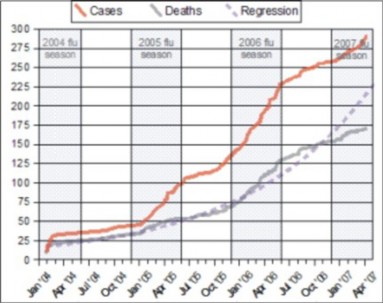
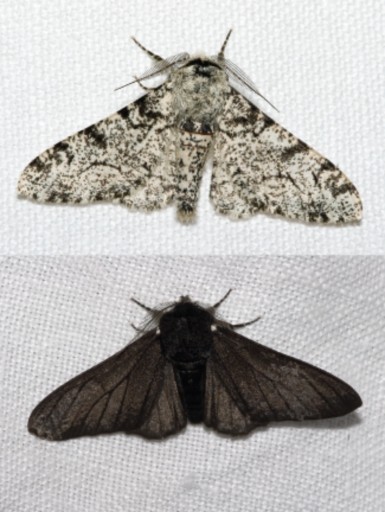
and availability of food. A severe drought and food shortage in 1977 led to a significant change. Birds whose small beaks could not crack the tough remaining seeds died, and the larger-beaked individuals who survived reproduced. The following year, offspring were larger bodied and larger-beaked, showing that natural selection led to evolution. A rainy winter in 1984-1985 reversed the trend; more soft seeds were produced, and the smaller beaked finches survived and reproduced in greater numbers than their large-beaked cousins.

Jonathan Winter eloquently describes the Grants’ work and discoveries in his Pulitzer Prize- winning The Beak of the Finch, A story of Evolution in our Time. His words urging that we see evolution as ongoing for all life make a fitting conclusion to this lesson and chapter:
(Source: http://en.wikiquote.org/wiki/Beak_of_the_Finch)
Lesson Summary
The process of evolution by natural selection continues to change our world and our selves, both despite and because of our best efforts to control it.
Beyond Darwin’s expectations, we have added direct observation of natural selection to the overwhelming evidence for evolution.
Humans have designed and produced crops, work animals, and companions through artificial selection.
Cultivation of crops gave us the freedom to develop civilization.
Hybridization improves the yield of crop species and adapts them to various environ- ments.
Habitat destruction is destroying raw materials for hybridization, and “escape” of “artificial” genes is “polluting” wild species.
Cloning has the potential to reproduce exact copies of selected individuals, but it goes against the principles which govern natural selection.
Genetic engineering, like traditional methods of breeding and domestication, designs medicines, plants, and animals to suit our goals.
Unlike traditional breeding, genetic engineering chooses single genes and can transfer them from one species to another completely unrelated species – making it faster, more precise, and far more powerful.
In both GE and traditional breeding, the potential for genetic pollution remains. Pol- lution is probably more likely for genetic engineering because developments proceed so quickly.
Products of genetic engineering include insulin and growth hormone, vaccines in milk and bananas, produce with longer growing season and shelf life and more nutrition.
Michael Pollan suggests that we are coevolving with our domesticated crops, animals, and pets, rather than producing them – in other words, that our products are domes- ticating us as we domesticate them!
Bacteria have developed serious levels of resistance to antibiotics because humans have introduced a new selective force into their environments (our bodies).
An individual bacterium has its own set of genes. If these genes do not confer resistance to antibiotics, the bacterium by itself cannot develop resistance. A population can develop resistance if some of its members have, by chance, the gene for resistance.
The evolution of antibiotic resistance has already resulted in a number of bacteria resistant to most known antibiotics; these are sometime called “superbugs.”
Actions you can take to prevent or slow the evolution of antibiotic resistance include:
Don’t take antibiotics for viral infections.
Take prescribed antibiotics exactly as prescribed.
Never take antibiotics which are left over or belong to someone else.
Consider purchasing meats from animals not treated with antibiotics.Consider purchasing organic produce.
Resist the use of pesticides in your own gardens.
Viral epidemics occur when chance viral mutations adapt the virus to new hosts or new methods of transmission.
Peppered moth populations changed color as the Industrial revolution changed the color of their habitat.
Peter and Rosemary Grant studied two closely related species of Darwin’s finches and recorded changes in beak size and body size which paralleled changes in weather.
Review Questions
List the ways in which we have directly observed evidence for evolution and/or natural selection.
Describe the importance of artificial selection to human life.
What is genetic pollution and why does it matter?
Compare cloning to natural selection.
Give examples of useful products of genetic engineering.
Explain Michael Pollan’s ideas about our relationship with our domesticated crops, animals, and pets, and give your opinion about them, using examples from your own experience.
Use the concept of natural selection to explain the resistance of bacteria to antibiotics and insects to pesticides.
Explain why an individual bacterium cannot on its own change from sensitive to re-
sistant to antibiotics.
Choose two actions you think would be most likely to control the increase in antibiotic resistance, and support your choices with examples from your own experience.
In what way do viral epidemics demonstrate evolution?
Further Reading / Supplemental Links
Michael Pollan, 2001. The Botany of Desire, Random House, 2002.
David Quammen, 1997. The Song of the Dodo: Island Biogeography in an Age of Extinctions. Scribner.
Carl Sagan, 1980. Cosmos. Random House New Edition, May 7, 2002, 384 pgs – also available in video and DVD, as Cosmos: A Personal Voyage.
Jonathan Weiner, 1994. The Beak of the Finch: A Story of Evolution in Our Time.
Alfred A. Knopf.
http://www.fda.gov/oc/opacom/hottopics/anti_resist.html
http://www.cdc.gov/drugresistance/community/
http://whyfiles.org/038badbugs/
http://www.niaid.nih.gov/factsheets/antimicro.htm
http://www.who.int/mediacentre/factsheets/fs194/en/
http://www.who.int/whopes/resistance/en/
http://library.thinkquest.org/19697/
http://www.fda.gov/fdac/features/2003/603_food.html
http://www.msichicago.org/exhibit/genetics/engineering.html
http://www.who.int/csr/disease/avian_influenza/en/
http://www.biologycorner.com/worksheets/peppermoth_paper.html
http://www.biologycorner.com/worksheets/pepperedmoth.html
http://bsgran.people.wm.edu/melanism.pdf
http://www.millerandlevine.com/km/evol/Moths/moths.html
http://crustacea.nhm.org/people/martin/publications/pdf/103.pdf
Vocabulary
artificial selection Animal or plant breeding; artificially choosing which individuals will reproduce according to desirable traits.
cloning The process of creating an identical copy of an organism.
coevolution A pattern in which species influence each other’s evolution and therefore evolve in tandem.
genetically modified organism (GMO) An organism whose genes have been altered by genetic engineering.
genetic engineering The manipulation of an organism’s genes, usually involving the in- sertion of a gene or genes from one organism into another.
genetic pollution The natural hybridization or mixing of genes of a wild population with a domestic or feral population.
geologic time Time on the scale of the history of Earth, which spans 4.6 billion years.
mutation A change in the nucleotide sequence of DNA or RNA.
natural selection The process by which a certain trait becomes more common within a population, including heritable variation, overproduction of offspring, and differential survival and reproduction.
transgenic animal An animal which possesses genes of another species due to genetic engineering.
To what extent do you think that humans have removed themselves from natural selection?
In what ways do you still feel subject to “natural” selective pressures?
How effective do you think the measures to limit evolution of antibiotic resistance will be? Are you willing to support them?
Do you think the benefits of genetic engineering outweigh the risks? Are there certain products you support, and others you oppose? Which ones, and why?
Image Sources
//upload.wikimedia.org/wikipedia/commons/b/b1/Wallace_biogeography.jpg. Public Domain.
http://en.wikipedia.org/wiki/Image:Horseevolution.png. GNU-FDL.
George. http://commons.wikimedia.org/wiki/Image: Charles_Darwin_by_G._Richmond.jpg. Creative Commons.
http://commons.wikimedia.org/wiki/Image:Siberian_Tiger_sf.jpg. CC-BY-SA-2.5, CC-BY-SA-2.5, 2.0, 1.0.
John Romanes. http://commons.wikimedia.org/wiki/Image:Homology.jpg. Public Domain.
http://commons.wikimedia.org/wiki/Image: Blaufu%C3%9Ft%C3%B6lpel_%28Sula_nebouxii_excisa%293.jpg. GNU-FDL, CC-BY-SA-2.0.
http://commons.wikimedia.org/wiki/Image:Atoll_forming-i18.png. Public Domain.
Romanes’s copy of Ernst Haeckel’s drawings. http://commons.wikimedia.org/wiki/Image:Haeckel_drawings.jpg. Public Domain.
Joanne and Matt. http://www.flickr.com/photos/joanne_matt/127758696/. CC-BY.
http://commons.wikimedia.org/wiki/Image:Zebrafisch.jpg. Copyright Free, Copyright Free.
http://commons.wikimedia.org/wiki/Image:Canis_lupus_lycaon_03.jpg. GNU-FDL, CC-BY-SA-2.5.
http://commons.wikimedia.org/wiki/Image:Palila.jpg http://en.wikipedia.org/wiki/Image:Iiwi.jpg http://commons.wikimedia.org/wiki/Image:Amakihi.jpg. Public Domain, Public Domain, Public Domain, Public Domain.
Jerry Crimson Mann. http://en.wikipedia.org/wiki/Image:Evolution_pl.png. Creative Commons.
http://commons.wikimedia.org http://commons.wikimedia.org/wiki/Image:Drosera_rotundifolia_ chromolithograph.jpg/wiki/Image:Calypso_bulbosa_Nordens_Flora_416.jpg. Public Domain.
http://commons.wikimedia.org/wiki/Image:Bactrian.camel.sideon.arp.jpg http://commons.wikimedia.org/wiki/Image:Guanaco_09.24.jpg. GNU-FDL, GNU-FDL, Public Domain, Public Domain.
London Sketchbook. http://commons.wikimedia.org/wiki/Image:Caricatura_de_Darwin.jpg. Public Domain.
Owen Stanley. http://commons.wikimedia.org/wiki/Image:HMSBeagle.jpg. Public Domain.
http://en.wikipedia.org/wiki/Image:
Snider-Pellegrini_Wegener_fossil_map.gif. Public Domain.
John Doebley. http://commons.wikimedia.org/wiki/Image:Teosinte.png. CC-BY-2.5.
http://commons.wikimedia.org/wiki/Image:Geochelone_nigra.png. CC-BY-2.5.
http://commons.wikimedia.org/wiki/Image:Amblyopsis_spelaeus.jpg http://en.wikipedia.org/wiki/Image:Crane_fly_halteres.jpg http://commons.wikimedia.org/wiki/Image:Cold_urticaria.jpg. (d)Public Domain.
Mark Putney. http://www.flickr.com/photos/putneymark/1226674080/. CC-BY-SA.
Cambridge University Press. http://commons.wikimedia.org/wiki/Image:Fuegian_BeagleVoyage.jpg. Public Domain.
http://commons.wikimedia.org/wiki/Image:Pfautaube.jpg http://commons.wikimedia.org/wiki/Image: Fiary_Swallow_%28Wing_Pigeon%29.jpg. GNU-FDL.
http://commons.wikimedia.org/wiki/Image:Antibiotic_resistance.svg. Public Domain.
Elembis. http://commons.wikimedia.org/wiki/Image: Mutation_and_selection_diagram.svg. GFDL.
Kipala. http://commons.wikimedia.org/wiki/Image:Voyage_of_the_Beagle.jpg. GFDL.
http://commons.wikimedia.org/wiki/Image: Biston.betularia.f.carbonaria.7209.jpg. CC-BY-SA-2.5, CC-BY-SA-2.5.
http://commons.wikimedia.org/wiki/Image:Lightmatter_chimp.jpg http://commons.wikimedia.org/wiki/File:Male_silverback_Gorilla.JPG http://commons.wikimedia.org/wiki/Image:Papio_ursinus.jpg. GNU-FDL, CC-BY-2.5, GNU-FDL, CC-BY-SA-2.5.
Waitak - - Duy Đức. http://en.wikipedia.org/wiki/Image: H5n1_spread_%28with_regression%29.png. GNU-FDL.
Mariana Ruiz Villarreal. http://commons.wikimedia.org/wiki/File: Megatherium_americanum_complete.JPG. Public Domain.
Janice Carr. http://commons.wikimedia.org/wiki/Image: Mycobacterium_tuberculosis_8438_lores.jpg. Public Domain.
Bev Sykes. http://commons.wikimedia.org/wiki/Image:Seattle-giraffe3.jpg. CC-BY-2.0.
Charles Darwin, Alexei Kouprianov. http://commons.wikimedia.org/wiki/Image:Darwin_divergence.jpg. Public Domain.
- Log in or register to post comments
- Email this page
